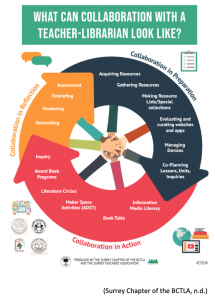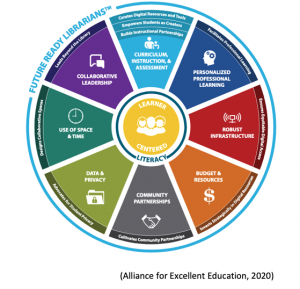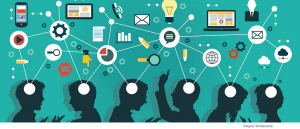“The Learning Commons is the starting point—it’s the nerve centre of the school, the place where learning isn’t about collecting dots but rather about connecting them …. It’s our experimental lab: a place where kids and adults can take risks and experiment with new ways of doing school … where educational research can be played with and developed into programs that not only impact students but also provide “road maps” for teachers: “This is what innovation looks like … how it engages students … and how you can implement facets of it in your own classroom.— Gino Bondi, LearningtheNow” (Ekdahl, M., & Zubke, S, 2017. P. 19)
Connections:
As a new TL who has been in a LLC part-time and has been mentored by TLs in our district, I have learned that one of the most important ways to support the school community is through building connections. Whether it be through supporting individual students or staff on research queries, or preparing teaching resources to supporting literary initiatives, a TL that actively builds connections with the school community, will be able to foster more supportive opportunities provided by the LLC. The ultimate goal for a LLC program is to create learning partnerships whereby “all members of the learning community work together to build virtual and physical learning partnerships in the LLC. These are global, connected, social, cross-curricular and complex” (Ekdahl, M., & Zubke, S, 2017. P. 6).
Ways to build connections with a school community are explored in Elizabeth Burns article, “Advocating for Change in School Library Perceptions.” She suggests considering the below when building connections with the school community:
-
-
-
- “Revitalize the perception of the school librarian:
- Library is open and accessible (physically and online)
- Build partnerships that involve community resources
- Be active in leadership at the school and district levels.
- Emphasize the teaching role of the school librarian
- Engage in active support of student learning through library programing
- Co-teach or team-teach with peers to integrate library skills.
- Share your expertise
- Innovation of the school librarian
- Demonstrate something unique or innovative about the school library
- Curate resources to include social media and online resources and tools
- Relevance of the school library
- Develop lessons that provide real-world applications of skills
- Integrate opportunities for use of multiple literacies”
- “Revitalize the perception of the school librarian:
-
-
(Burns, 2018, p. 12)
Burns’ suggestions for creating/building connections will help to promote visibility of the LLC, but also the TL. A teacher-librarian is able to build connections through showing how their expertise can support students, teachers and administration. Essentially, shaping perceptions of the role of the teacher-librarian should demonstrate LLC management, but also actively support literary and research initiatives. Creating a usable welcoming environment goes beyond just having books and a stellar collection. The TL needs to be creating collegial relationships and provide a workspace environment that the school community wants to visit. Providing an inviting space and showcasing services is the first step to building connections. As connections are built, supporting teachers with ICT and professional development can be achieved.
Collections & Communication:
Some of the direct ways our LLC supports teachers with ICT and professional development is through communication and the central sharing of the collection (digital and print). Our Library website is maintained through Weebly and directs students/staff/parents to our OPAC, Follett’s Destiny, and our district digital bundle from Focused Education as well as some school-based digital top-ups. Our virtual presence is still developing as we aim to expand our presence and hope to increase interactivity in a virtual LLC.
 One of the ways our LLC works with professional resources and curricular support references is through maintaining a physical collection in our LLC office. We have recently been expanding “Collections” on Destiny. A colleague has created collections within Destiny Discover that show staff how they can find Indigenous curricular supports, as divided by subject area. This was a large undertaking that then was shared at a school-based professional day. Staff have also been invited to a Google Classroom that offers curricular digital supports. This space collects ongoing technology information that is shared by our district as well as new digital curriculum resources. I cannot take any credit for the collections work or the Google Classroom Teacher Resources, as this was created by my colleague, but it has really helped our school community in all curricular areas.
One of the ways our LLC works with professional resources and curricular support references is through maintaining a physical collection in our LLC office. We have recently been expanding “Collections” on Destiny. A colleague has created collections within Destiny Discover that show staff how they can find Indigenous curricular supports, as divided by subject area. This was a large undertaking that then was shared at a school-based professional day. Staff have also been invited to a Google Classroom that offers curricular digital supports. This space collects ongoing technology information that is shared by our district as well as new digital curriculum resources. I cannot take any credit for the collections work or the Google Classroom Teacher Resources, as this was created by my colleague, but it has really helped our school community in all curricular areas.
Other ways we offer support to teachers with ICT and collection access is by supplying teachers with screencasts to share with their classes on how to access the databases or use Noodle Tools. These are tailored to teacher’s assignments and are not generic as we found key words central to our database demonstrations. These supports enable us to teach students researching skills when they are not able to come to the LLC, but they also enable teachers that wish to refresh their knowledge with databases. Many times, this offers us a chance to show our community all of the great resources that we can access.
Sharing collection information is communicated in many different ways. We provide library displays, which we now are also sharing on social media. We also occasionally send out email blasts that inform what is new. These emails are tailored to those that would find them useful. For example, the installments of What in the World typically goes to English, Social Studies, ELL, LAC and sometimes if there are science or math topics, those departments would be included. We really aim to not inundate staff with emails, and have found the centralized location on Google Classroom for Teacher Resources to be helpful with minimizing email blasts. School news bulletins and staff meetings sometimes include LLC news.
Collaboration:
Leading Learning defines the learning commons as being “a whole school approach to building a participatory learning community. The library learning commons is the physical and virtual collaborative learning hub of the school. It is designed to engineer and drive future-oriented learning and teaching throughout the entire school.” (CSL, 2020). Collaboration is central to the pedagogy that we promote in our LLC program. Richmond School District’s “Evolution of the Library” shows how LLC programs promote collaboration within a school community, but it also highlights how teacher-librarians “can be educational leaders – innovative change agents in the entire learning community” (Richmond SD38, 2019).
Collaborating can take many forms. It can be introduced through teacher interactions and from the connections a TL has built with staff. It can be through department interactions. We have participated in attending department meetings to listen to current curricular developments. Below are some of the ways we collaborate:
- Project research query: Teachers are welcome to come to the LLC to meet with us to discuss new projects that we can support. Classroom teachers are able to book LLC time, or have a TL come to their classroom. This can be to help support research queries or to support media literacy, etc.
- Topic brainstorm: Teachers can email or let us know about an upcoming topic they’d like to explore in the curriculum. Is there a way that we can support? Share resources? Collaborate with an activity?
- TL reach-out – We may find a new resource and think it might be great in a curricular area. Presenting the resource to a classroom teacher can introduce a new resource, but it also can enable and invitation to collaborating. Or, we may have a teacher who has expressed interest in VR but doesn’t know how this can be used in his curricular area. We would ask questions about a topic he’d like to explore with VR and curricular goals. The TL team would investigate activities that could support the teacher and share ideas. Sometimes these ideas will stick and a lesson can be developed around this new technology and other times, they might evolve into something different.
- Wider staff reach-out or general zaps. These are similar to library news feeds where new collection material and technology can be showcased briefly and also offers a connection/reminder that the LLC team is available to support.
We are seeing a lot more teachers reaching out for tech collaboration during the pandemic. This initially started out as remote teaching support but has evolved into helping with loaning equipment for screencasts. There has been an exponential amount of requests for green screens and microphones. Requests for familiarization or access to our digital resources have also increased with the hybrid learning approach.
Doug Johnson describes today’s school librarian as an “ultimate digital resource” (Johnson, 2019). He discusses how “we’ll know students are ‘future ready’ when we see them ‘inquiring, including, collaborating, curating, exploring, and engaging in and outside of the library and across content areas’ and that ‘this will only happen if school librarians collaborate with teachers and share their technical expertise and knowledge of digital resources’” (Johnson, 2019). Johnson outlines six roles that ‘digital librarians’ should embrace to facilitate, demonstrating collaboration and professional development:
-
-
-
- “Curating resources to support individualized instruction
- Sharing expertise in locating and evaluating resources
- Helping students—and teachers—produce digital content
- Being the “digital copyright guru”
- Teaching digital citizenship and online safety
- Planning and managing school maker-spaces”
-
-
(Johnson, 2019).
Johnson explains that whilst supporting digital resources is not a new role for teacher-librarians, it is becoming an area of more importance. “It’s essential that librarians keep current on trends in tech through their own professional development. Whether they’re developing technology skills for the entire school through professional development initiatives or helping staff members one-on-one, digital librarians are a must-have resource for schools that want to use technology effectively for learning” (Johnson, 2019). A teacher-librarian must be tech savvy and stay on top of tech trends, as an essential element of a TL role is in supporting and helping teachers with using technology in their teaching as well as integrating it with lesson/project delivery.
References:
Alliance for Excellent Education. 2020. “Future-Ready Librarians”. [image]. Retrieved 26 February, 2021 from https://futureready.org/program-overview/librarians.
Burns, E. A. (2018). “Advocating for Change in School Library Perceptions.” Teacher Librarian, 46, 8-14.
Canadian School Libraries (CSL). (2020). “Leading Learning: Standards of Practice for School Library Learning Commons in Canada.” Retrieved 24 February 2021 from http://llsop.canadianschoollibraries.ca
Johnson, Doug. (2019). “The School Librarian: Your Ultimate Digital Resource”. The Tech Savvy School. Educational Leadership. 76(5). Retrieved on 24 February 2021 from http://www.ascd.org/publications/educational-leadership/feb19/vol76/num05/The-School-Librarian@-Your-Ultimate-Digital-Resource.aspx
Ekdahl, M., & Zubke, S. (2017). From School Library to Library Learning Commons. Retrieved 24 February 2021 from https://bctladotca.files.wordpress.com/2017/11/school-library-to-library-learning-commons.pdf
Richmond SD38 (Producer). (2019). The Evolution of the Library [Video file]. Retrieved 24 February 2021 from https://youtu.be/5sadWGKFs4k
Surrey Chapter of the BCTLA. (n.d.). Collaboration. [image]. Retrieved 23 February 2021 from
https://www.surreyschools.ca/llc/instructionalpractice/collaboration/Pages/ default.aspx



 Follow
Follow
This was a very comprehensive review of many useful strategies, approaches and guides for T-Ls and library programs to support their entire school community. The organization and structure of your overview was helpful as it explored the ‘layers’ of support and guidance and also provided some very useful examples and practical advice for others. Its great to read about the sucesses and new inititatives you are supporting and cultivating. To hear about teachers making the shift and using new tools, mediums and formats to build learning artificats and to reach out to the T-Ls and Library program for supports is very encouraging.
Thanks for sharing this wonderful information, this is very interesting about how TL can support teachers with technology and professional development. The suggestions that explain how to build connections with the school community are very inspiring.
I wonder if you have suggestions for teacher-librarians in small schools that have less resources and less funding, where to start? What will be the first step to take in developing a learning community based on the model presented here?
Thank you.